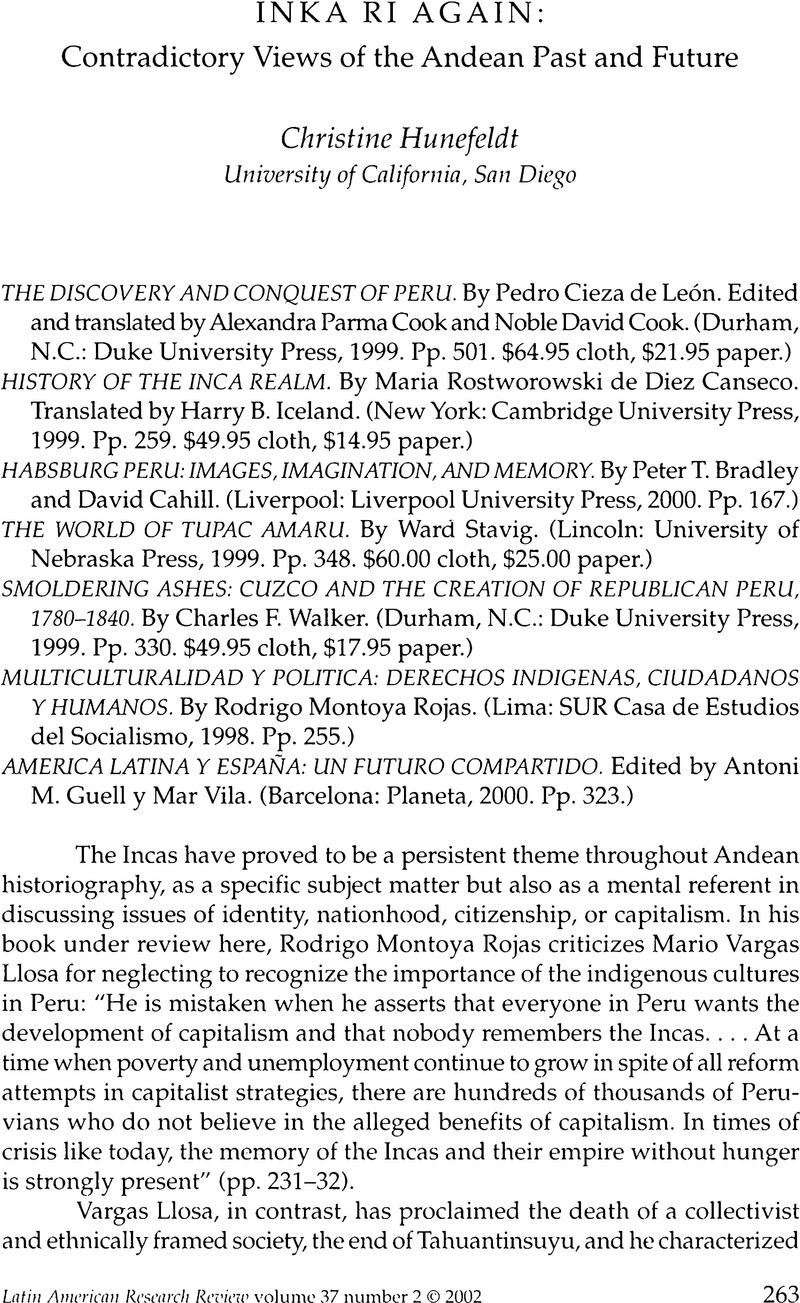No CrossRef data available.
Article contents
Inka ri Again: Contradictory Views of the Andean Past and Future
Review products
Published online by Cambridge University Press: 05 October 2022
Abstract

- Type
- Review Essays
- Information
- Copyright
- Copyright © 2002 by the University of Texas Press
References
1. Mario Vargas Llosa, La utopía arcaica: José María Arguedas y las ficciones del indigenismo (Mexico City: Fondo de Cultura Económica de México, 1996), 335. See also his essay “Global Village or Global Pillage,” in Global Fortune: The Stumble and Rise of World Capitalism, edited by Ian Vásquez (Washington, D.C.: Cato Institute, 2000).
2. Alberto Flores Galindo, Buscando un Inca (Lima: Horizonte, 1988).
3. Some intriguing articles were recently compiled in a commemorative volume for Maria Rostworowski, edited at the Instituto de Estudios Peruanos in Lima. See Arqueología, antropología e historia en los Andes: Homenaje a María Rostworowski, edited by Rafael Varón and Javier Flores (Lima: Instituto de Estudios Peruanos), 1997.
4. Other regions in Peru have attracted much less attention, and the themes analyzed in other regions diverge greatly from the concerns focusing on Cusco. One such region is Arequipa, where caudillo politics have dominated the regional scene with its anti-centralist strands. Another region is Puno, important as a region linking the mining center of Potosí in colonial times and in the nineteenth and twentieth centuries as the region where gamonalismo flourished. Cajamarca and Trujillo stand out for different reasons. It is to be hoped that someday, scholars will be able to assemble our knowledge of Andean regions in a comparative framework. For a recent analysis on Arequipa between 1780 and 1854, see Sarah C. Chambers, From Subjects to Citizens: Honor, Gender, and Politics in Arequipa, Peru, 1780–1854 (University Park: Penn State University Press), 1999.
5. His provisions included cash, tangible items, and prayers for Indian souls.
6. Miguel Izard, América Latina, siglo XIX: Violencia, subdesarrollo y dependencia (Madrid: Síntesis, 1990). See also his more recent publication, El rechazo a la civilización: Sobre quienes no se tragaron que las Indias fueran esa maravilla (Barcelona: Península, 2000), 154.
7. Perhaps a more realistic way to deal with opposing visions, realities, and meanings of the past is to look into what others have called syncretism or hybrid colonial order or protonationalism. See Kenneth J. Andrien, Andean Worlds: Indigenous History, Culture, and Consciousness under Spanish Rule, 1532–1825 (Albuquerque: University of New Mexico Press, 2001); and Terence N. D'Altroy and Christine Ann Hastof, “Empire and Domestic Economy,” forthcoming.




